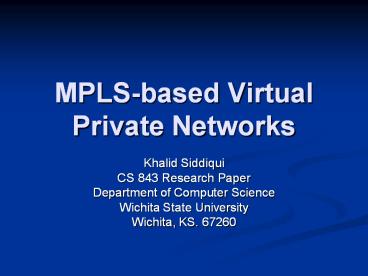MPLS-based Virtual Private Networks PowerPoint PPT Presentation
1 / 14
Title: MPLS-based Virtual Private Networks
1
MPLS-based Virtual Private Networks
- Khalid Siddiqui
- CS 843 Research Paper
- Department of Computer Science
- Wichita State University
- Wichita, KS. 67260
2
Presentation Outline
- To describe the
- Need
- History
- Working
- Benefits
- Of MPLS-based Virtual Private Networks
3
Why MPLS-based VPNs?
- Trends in Enterprise Computing
- 1. Companies having offices scattered
throughout the country. - 2. On-the-run employees.
- Network Congestion
- Better QoS required for Voice over IP and
converged voice and data networks. - Security
- More sophisticated and costly attacks on
networks.
4
Definition/Features of MPLS
- Stands for Multi-protocol Label Switching.
- A technology for speeding up network traffic flow
and making it manageable. - Works by attaching a label in front of each
packet. - At each subsequent hop in the network, the router
only takes a look at the label and forwards it. - This is in contrast to the normal switching where
routers look at the IP address of each packet and
forward it accordingly. - This is how MPLS saves time and make traffic flow
faster and smoother.
5
MPLS Features Contd.
- Label Distribution Each LSR in the network
maintains a table of incoming interface, label
and outgoing interface, label. - Resource Reservation MPLS allows the reservation
of bandwidth beforehand to ensure the continuous
transmission of audio and/or video data. - Traffic Engineering Process of directing and
diverting traffic to where there are resources
available. Factors that affect Traffic
Engineering are - Current available resources
- Current and future state of the network
- QoS Requirements
6
(No Transcript)
7
MPLS Terminology
- Egress Exit point from the network.
- FEC Forwarding Equivalence Class. A sequence of
packets that are routed the same way, meaning
through the same LSP. - Ingress Entry point into the network.
- LER Label Edge Router. An LSR at the edge of an
MPLS network. These routers usually make up the
ingress and egress of the network. - LSR Label Switching Router. A part of the MPLS
network that forwards packets based on the label
attached in front of the packets.
8
Benefits of MPLS
- Faster Packet Switching.
- Better management of different kinds of traffic
(voice, data or converged). - Bandwidth Reservation for different Quality of
Service. - Works with Internet Protocol (IP), Asynchronous
Transfer Mode (ATM), Frame Relay thus
multiprotocol. - Expected to work with future technologies.
9
Definition/Features of VPN
- Stands for Virtual Private Network.
- A VPN is a private network that uses a public
network such as the Internet to provide secure
remote access to the corporate network for its
employees. - This is in contrast to earlier, expensive leased
lines. - It works by sharing the same public
infrastructure while providing security with the
help of encryption and tunneling protocols. - Data (packets) is encrypted by the sender and
decrypted by the receiver. - Only data that is encrypted properly enters a
particular tunnel.
10
Fig. 2 Virtual Private Network
11
VPN Terminology
- Tunneling Transmission of private data through
the public network such that the routing nodes in
the network are unaware that the transmission is
part of a private network. - Encryption The conversion of data into a form
called ciphertext that is not understandable to
anyone whos not authorized to look at it. - L2TP Layer 2 Tunneling Protocol, a common
tunneling protocol. - PPTP Point to Point Tunneling Protocol, another
common VPN tunneling protocol.
12
Benefits of VPN
- Extend connectivity of a corporation beyond
geographic boundaries. - Provide secure connections.
- Reduce expenditure and costs as compared to
leased lines or WANs. - Eliminate the need for transportation of remote
users. - Provide potential for networking in a global
environment.
13
Conclusion
- MPLS-based Virtual Private Networks promise
a lot of potential when properly designed. - Virtual Private Networks provide the highly
desirable benefits of low-cost, high speed,
and secure connection. - MPLS, on the other hand, provide better
Quality of Service based on Traffic Engineering
and Resource Reservation. - So, I expect to see these kind of networks in
heavy use in the near future.
14
References
- Brittain, Paul and Adrian Farrel, MPLS Virtual
Private Networks, http//www.dataconnection.com/do
wnload/mplsvpns.pdf, November, 2000. - Brittain, Paul and Adrian Farrel, MPLS Traffic
Engineering A choice of signalling protocols,
http//www.dataconnection.com/download/
crldprsvp.pdf, January 17, 2000. - joevans_at_cisco.com, MPL VPNs, http//www.ripe.net/r
ipe/meetings/ archive/ripe-39/presentations/mpls-v
pn/, Novermber 2001. - Spirent White Paper, BGP/MPLS Virtual Private
Networks Performance and Security over the
Internet, http//adtech.spirentcom.com/download/
literatureqqw8/marketingliterature/W5103_RFC_2547.
pdf. - Tyson, Jeff, How Virtual Private Networks Work,
http//computer.howstuffworks.com/vpn.htm/printabl
e.

